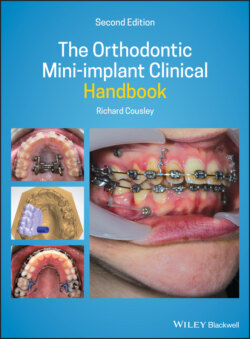Читать книгу The Orthodontic Mini-implant Clinical Handbook - Richard Cousley - Страница 19
1.6.3 Direct and Indirect Anchorage
ОглавлениеDirect loading is when traction is applied from the mini‐implant's head to an appliance, typically with elastic chain or nickel titanium (NiTi) coil springs (Figure 1.2a). Indirect loading involves using the mini‐implant to reinforce anchor teeth, from which traction is applied (Figure 1.2b,c). The most commonly shown example of this involves midpalatal mini‐implant(s) anchorage of the first molars. This approach is advocated because of the high success rates of parasagittal mini‐implants, even in adolescents. For example, a retrospective study of 384 parasagittal mini‐implants inserted by Dr Björn Ludwig (in Germany) gave a 98% success rate [6]. Whilst indirect anchorage also has a potential advantage of avoiding some potential biomechanical side‐effects (discussed later in this chapter), it carries the risk of insidious anchorage loss through flexing of the intermediary wire connection and undetected tipping or bodily translation of the mini‐implant. This has been reported to cause up to 0.5 mm of movement (anchorage loss) of the anchor tooth, in any one plane, when it is connected by a short piece of 0.019 × 0.025 in steel wire to a mini‐implant [7], and 1–1.4 mm mean anteroposterior mesial drift of indirect molars in cases treated with bimaxillary incisor retraction [8].
Becker et al. [9] recently published a meta‐analysis of en masse retraction treatments involving direct (buccal mini‐implants) and indirect (palatal) anchorage [9]. Their results show that direct traction techniques provided better anchorage control than indirect anchorage approaches in both anteroposterior and vertical planes. This appears to have been due to occult mesial migration of some palatal mini‐implants and bending of the transpalatal arch (TPA) component. Therefore, it was recognised that direct anchorage provides better outcomes in terms of anchorage control despite the possibility of higher mini‐implant stability in midpalate sites. Interestingly, the favourable biomechanical effects of direct anchorage, such as controlled bodily movement of target teeth, were not studied in this meta‐analysis, but represent an additional clinical benefit of direct anchorage usage [10–14]. This aspect will be discussed in detail at the end of this chapter.
In summary, I prefer to use direct anchorage wherever possible and this will be elucidated in the clinical scenario chapters. A key exception to this rule occurs in young patients whose bone immaturity means that the higher success rates of midpalate sites negates the biomechanical limitations of indirect anchorage. In effect, direct anchorage prioritises biomechanical considerations and indirect anchorage focuses on anatomical factors.
Direct anchorage provides better outcomes in terms of anchorage control despite the possibility of higher mini‐implants stability in midpalate sites.
